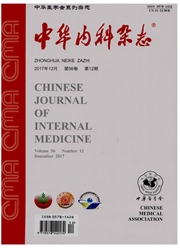

 中文摘要:
中文摘要:
目的探讨异基因造血干细胞移植(allo—HSCT)后患者并发肾病综合征(NS)的发病、诊断及治疗情况。方法分析1996年1月至2009年4月在北京大学人民医院完成的1464例人类白细胞抗原(HLA)配型相合和不合的亲缘间造血干细胞移植,生存期大于100d的血液病患者1405例,8例(0.6%)发生移植后NS。收集患者的临床资料,并选定同期移植的56例患者作为对照组,采用巢式病例对照研究进行危险因素分析。结果8例患者发生Ns的中位时间为移植后488(54—1185)d,表现为双下肢水肿、大量蛋白尿;2例伴有肾功能异常。6例患者曾有慢性移植物抗宿主病(GVHD)。3例患者发生NS时伴有GVHD其他表现。4例患者肾脏病理结果显示,3例为微小病变,1例为膜性肾病。经联合免疫抑制剂治疗均有效。1例患者停药后NS复发。1例患者白行离院,早期死亡;1例患者白血病复发后死亡;其余6例患者目前均无病生存。分析与NS发生的关系发现,慢性GVHD是NS的独立危险因素。结论allo—HSCT患者出现水肿、蛋白尿,应注意甄别NS,可能与慢性GVHD有关,联合免疫抑制剂治疗反应良好。
 英文摘要:
英文摘要:
Objective To explore the incidence, diagnosis and treatment of nephrotic syndrome (NS) following allogeneie hematopoietic stem cell transplantation (allo-HSCT) in one single center. Methods Analysis were carried out based on the records of 1464 patients following allo-HSCT hospitalized in Peking University People's Hospital from January 1996 to April 2009, so as to evaluate the incidence and outcomes of NS. A total of 1464 patients whose survival time was longer than 100 d were enrolled. Eight patients (0. 6% ) had NS following allo-HSCT received transplantation within the same period Using the nested case-controlled study, 56 cases who were selected as control group for risk factors analysis. Results The median time of NS was 488 (54-1185) d after allo-HSCT. Lower extremities' edema and heavy proteinuria were present in all the patients. Two patients were accompanied with impaired renal function. Six patients suffered from chronic graft-versus-host disease (GVHD). Three patients with NS were accompanied with other symptoms of GVHD. Renal biopsy examination showed typical features of minimal change diseases in 3 patients and membranous nephropathy in 1 patient. All cases achieved complete remission (CR) after taking combined immunosuppressant agents. One patient relapsed soon after all the immunosuppressant agents were stopped. Six patients were still surviving with disease free. One patient died of the relapse of leukemia and another patient died of early discharge from hospital after allo-HSCT. The possible factors correlated with the occurrence of NS were analyzed, and the occurrence of chronic GVHD was identified as an independent factor of NS. Conclusions NS should be carefully taken into consideration when edema and proteinuria are present in patients following allo-HSCT. The occurrence of NS is probably related with chronic GVHD. NS responds well to immunosuppressant agents.
 同期刊论文项目
同期刊论文项目
 同项目期刊论文
同项目期刊论文
 Effects of the NK cell recovery on outcomes of unmanipulated haploidentical blood and marrow transpl
Effects of the NK cell recovery on outcomes of unmanipulated haploidentical blood and marrow transpl Partially matched related donor transplantation can achieve outcomes comparable with unrelated donor
Partially matched related donor transplantation can achieve outcomes comparable with unrelated donor High CD4/CD8 ratio in allografts predicts adverse outcomes in unmanipulated HLA-mismatched/haploiden
High CD4/CD8 ratio in allografts predicts adverse outcomes in unmanipulated HLA-mismatched/haploiden First-line therapy for chronic graft-versus-host disease that includes low-dose methotrexate is asso
First-line therapy for chronic graft-versus-host disease that includes low-dose methotrexate is asso Expression profiles of adhesion molecules on na?ve T cells in bone marrow grafts of healthy donors t
Expression profiles of adhesion molecules on na?ve T cells in bone marrow grafts of healthy donors t Superior graft-versus-leukemia effect associated with transplantation of haploidentical compared wit
Superior graft-versus-leukemia effect associated with transplantation of haploidentical compared wit Expression of CD62L on donor CD4(+) T cells in allografts: correlation with graft-versus-host diseas
Expression of CD62L on donor CD4(+) T cells in allografts: correlation with graft-versus-host diseas Characterization of CD3+CD4-CD8- (double negative) T cells reconstitution in patients following hema
Characterization of CD3+CD4-CD8- (double negative) T cells reconstitution in patients following hema Administration of short-term immunosuppressive agents after DLI reduces the incidence of DLI-associa
Administration of short-term immunosuppressive agents after DLI reduces the incidence of DLI-associa Immune-related late-onset hemorrhagic cystitis post allogeneic hematopoietic stem cell transplantati
Immune-related late-onset hemorrhagic cystitis post allogeneic hematopoietic stem cell transplantati Graft-versus-leukemia effects of Wilms' tumor 1 protein-specific cytotoxic T lymphocytes in patients
Graft-versus-leukemia effects of Wilms' tumor 1 protein-specific cytotoxic T lymphocytes in patients The inferiority of G-PB to rhG-CSF-mobilized blood and marrow grafts as a stem cell source in patien
The inferiority of G-PB to rhG-CSF-mobilized blood and marrow grafts as a stem cell source in patien Conflicting impact of alloreactive NK cells on transplantation outcomes after haploidentical transpl
Conflicting impact of alloreactive NK cells on transplantation outcomes after haploidentical transpl Modified donor lymphocyte infusion (DLI) for the prophylaxis of leukemia relapse after hematopoietic
Modified donor lymphocyte infusion (DLI) for the prophylaxis of leukemia relapse after hematopoietic Platelet engraftment in patients with hematologic malignancies following unmanipulated haploidentica
Platelet engraftment in patients with hematologic malignancies following unmanipulated haploidentica Wilms' tumor gene 1 expression: an independent acute leukemia prognostic indicator following allogen
Wilms' tumor gene 1 expression: an independent acute leukemia prognostic indicator following allogen Immunomodulatory strategies for relapse after haploidentical hematopoietic stem cell transplantation
Immunomodulatory strategies for relapse after haploidentical hematopoietic stem cell transplantation Monitoring MRD with flow cytometry: an effective method to predict relapse for ALL patients after al
Monitoring MRD with flow cytometry: an effective method to predict relapse for ALL patients after al Treating donor mice with rhIL-11 and rhG-CSF promotes transplant-tolerance and preserves the effects
Treating donor mice with rhIL-11 and rhG-CSF promotes transplant-tolerance and preserves the effects The effect of HLA disparity on clinical outcome after HLA-haploidentical blood and marrow transplant
The effect of HLA disparity on clinical outcome after HLA-haploidentical blood and marrow transplant Unmanipulated HLA-mismatched/haploidentical blood and marrow hematopoietic stem cell transplantation
Unmanipulated HLA-mismatched/haploidentical blood and marrow hematopoietic stem cell transplantation Individualized Intervention Guided by BCR-ABL Transcript Levels after HLA-Identical Sibling Donor Tr
Individualized Intervention Guided by BCR-ABL Transcript Levels after HLA-Identical Sibling Donor Tr Basiliximab for the treatment of steroid-refractory acute graft-versus-host disease after unmanipula
Basiliximab for the treatment of steroid-refractory acute graft-versus-host disease after unmanipula Diarrhea during the Conditioning Regimen Is Correlated with the Occurrence of Severe Acute Graft-ver
Diarrhea during the Conditioning Regimen Is Correlated with the Occurrence of Severe Acute Graft-ver 期刊信息
期刊信息
